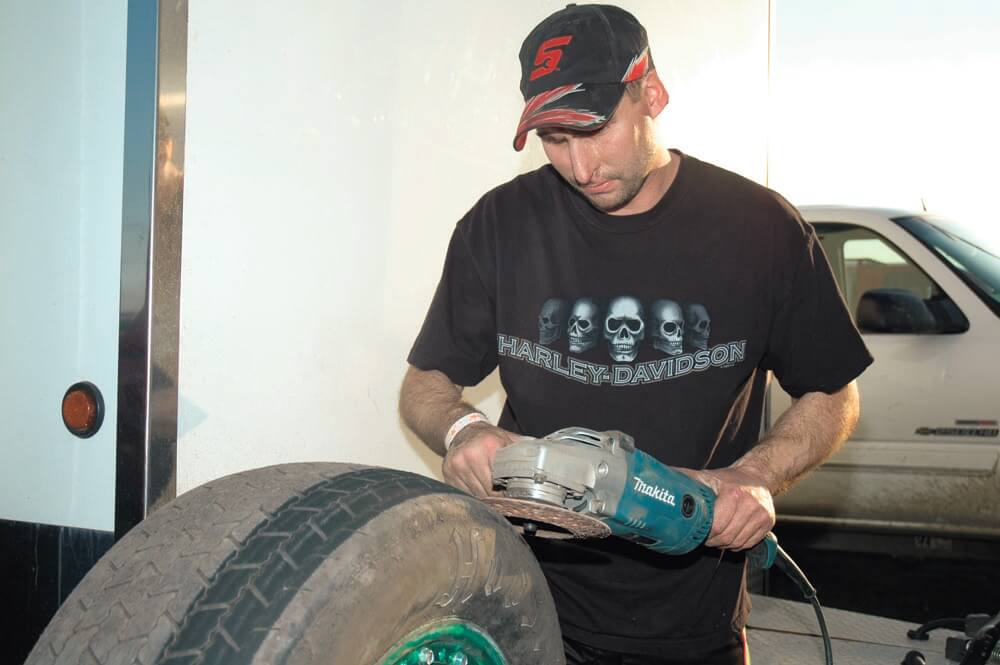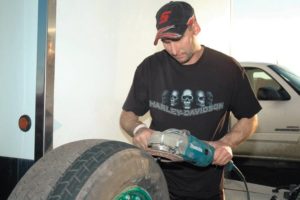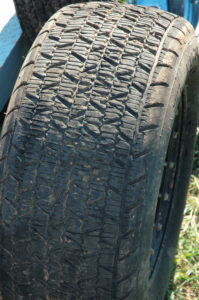Want to get a nasty look from the crew of a touring dirt late model? Walk over and peek under the covers they often place over their tires between races. Sure, they might be keeping the sun from heating their tires, but they’ve also spent a lot of time prepping the treads on those tires in magical, near-mystical ways. Knowing how and when to sipe, grind, and/or groove tires plays a significant role in the success of professional late model drivers, and they generally prefer to keep that information to themselves.
Siping is the practice of using a thin blade to slice slits in a tire’s tread. Grinding uses a grinding or sanding wheel to remove a thin layer of rubber from the entire tread surface. Grooving is a third form of mechanical tire preparation that uses a special heated tool to cut additional grooves in a tire’s tread.
Mechanical preparation of tire treads is an inexact science because of the variable nature of dirt tracks. Racing surfaces vary not only from track to track, but during a night’s racing at the same track. It’s impossible for tire companies or race teams to run controlled tests and definitively say that grinding, siping, or grooving tires in a specific pattern or to a specific depth gives specific amounts of additional traction, heating, cooling, or tread life.
While there are no absolute specifications about mechanical preparation of dirt track tires, there are lots of opinions. Speedway Illustrated sampled a range of dirt racing experts for their opinions about what works and doesn’t work when it comes to mechanical tire preparation of dirt track tires.
Siping
Wayne Harris, Day Motorsports: “First and foremost, if guys are going to mechanically prep their tires, they need to get a pyrometer and record tire readings to see how siping, grinding, or grooving affects tire temperatures. They need to get a probe-type pyrometer, rather than an infrared one, and they need to check their tires as soon as they come off the track. If they have to drive a quarter mile to get to the pits, or drive through mud to get there, their readings are going to be off. Check the inside edge, the center, and the outside edge of each tire and record the readings. You may have a right rear that’s within a degree or two of 220 degrees all across its tread but a left rear that’s uniformly 200 degrees across its tread—that’s fine because those tires are under different loads. The goal is to get the tread temperature uniform across the width of each tread. If the temperature of a tire varies from edge to center to edge, first look at air pressure, then see if the way you siped or grooved the tire is changing the way it builds or releases heat from the blocks in the tread.
Dave Mateer, American Racer Tires: “We supply tires that are race ready. Most racers benefit more by focusing on their setup than being distracted by [mechanically prepping] tires, but I’ll tell you what racers have told me: Sipes create heat. They create edges that wiggle and rub against each other as the tire is pressed against the track. That movement creates heat, which can be your friend for traction but your enemy for wear.”
Steve Norris, crewman and tire prep for dirt late model driver Billy Moyer for over 20 years: “Siping makes a tire ‘fire’ quicker—get up to temperature faster. Say there’s a D55 tire rule and the track is muddy for the heats. You’ll want a tread that’s all cut up so it can move around, build heat fast, and give you some bite. Later that night, once the track hardens up, you’ll want less siping because that would let the [tread] move around too much, build too much heat, and maybe blister. You can play with the depth of siping a little in a long race. Shallow sipes lets a tire heat up and act softer early, then, as they wear away, you’re back to a more solid tread for the last part of a race, where the track may be locked down and you need a harder tire.”
Zach Johnson, 2007 and 2008 WISSOTA late model national champion: “I sipe my front tires at a 15-degree angle, from eight o’clock to two o’clock. That’s what some guys who I trust told me, and I’m happy with the way they work. On the rears, I sipe straight across the blocks. One time I ran 15-degree sipes on the rear and after the race I could tell those tires weren’t as worn as the tires I had siped straight across. That tells me the 15-degree sipes weren’t biting as much, so I stick with cross-siping all my rear tires.”
Bob Hampshire, long-time sprint car owner and crew chief, member of the National Sprint Car Hall of Fame: “I think siping can help a tire heat up and help it cool down. The rubbing of all the edges helps a tire heat up, but the cuts also help cool a tire when you’re coasting under a yellow, which reduces blistering problems. Siping seems to help dissipate the heat from the center of the tire under those conditions.
Norris: “Siping really isn’t for traction, it’s for heating, but the little edges do play a role in traction. That’s why we sipe across the tread blocks on the rear tires, and around the circumference of the front tires.”
Harris: “Siping doesn’t change the tire’s durometer reading, but it helps make a medium-compound tire heat up and act like a soft-compound tire. Done right, siping can help a hard-compound tire work like a medium-compound tire.”
Grinding
Mateer: “Drivers talk about their tires “sealing over” or getting “glazed.” No one knows what is happening but one theory is that the heating of the tire during a race liquefies resins in the rubber compounds. These resins work to the surface and you get that shiny, glazed look and a slicker surface if the tire cools off during a caution or between races. Combine that sealed surface with the mechanical polishing of the tread simply by spinning of the tire, and you lose bite. Grinding removes that microscopic layer of sealed rubber and mechanically roughs up the smoothed tread blocks to give more bite.”
Norris: “Ten or 15 years ago we might have ground our tires at the start of the night and never touched them again, but now we’re cleaning and grinding every tire after every heat race and before the features. If a track is really slick, we’ll use an aggressive stone on the grinder. If the track has some bite, we’ll maybe use a 40-grit sandpaper. You’ve got to be careful using real aggressive stones so you don’t tear up the edges of any sipes you’ve put in the tread, because that can lead to chunking.”
Harris: “Let’s say you’re running an American Racer G60 on a really dry-slick track. There’s a good chance it will come in glazed over. Sometimes you can actually see a change in the color of the tread [compared to the rest of the tire]. Grinding removes that smooth layer and gets you back to good rubber.”
Mateer: “To a degree, even brand-new tires have a sealed surface. Some guys claim they get better results out of a new tire if they grind that factory shine off the tread before they use it. To get everything possible out of a new tire, put it through a couple heat-cool cycles before you really race it. Re-measure it, find out what its stagger is, set your car up properly, and you’ll get your best performance without grinding.”
Johnson: “On a new tire I’ll use an aggressive grit running at a slow speed. I’m trying to get rid of the release agent that the manufacturer uses to make the tires easier to remove from their molds. I just want to get down to un-shiny rubber. There have been times when I had to run a brand-new, un-ground tire on the right rear, and I could definitely tell it took three or four laps longer for it to fire than the tires that were already ground and broken in.”
Norris: “[You know] those deals where there’s a crewman grinding tires between trailers, and you can’t see the guy from all the rubber smoke—that’s a bad deal. If that tire is smoking, it’s too hot. You’re probably overworking the rubber, changing it chemically, and actually sealing it over. If you’re grinding a tire right, you see very little smoke—just rubber dust.”
Hampshire: “Some guys get real picky about grinding clockwise or counterclockwise patterns on their tires, depending if it’s a front or rear tire, maybe even whether it’s a right- or left-side tire. I don’t really care about the grinding pattern—I just want that shiny surface off the tread.”
Kent Arment, WISSOTA 2001 late model and modified champion, 2004 late model champion, 2005 modified champion: “I use a 60-grit and try to make the tops of the blocks flat across the surface of the tread. That makes the edges of the grooves and sipes crisp and sharp. I think that when you’re under power you’re actually running on those edges as much as the centers of the blocks, so I want those edges as sharp as possible to give me all the bite they can.”
Grooving
Hampshire: “You can hurt yourself with grooving if don’t know what you’re doing. I think the heat of the grooving iron does something to the rubber on the edges of the grooves. There are situations on a really slick track where it seems like the edges of the tooled grooves peel over. For a while you’re running on those little edges that roll over under pressure, and it’s like running on marbles. Eventually they wear or tear away, and then you’ve got rounded edges, which is just as bad, because those rounded edges really reduce bite. Sharp edges are what give you bite.”
Mateer: “Factory edges seem to hold up better than grooving iron-edges. I don’t know why. It’s a balancing act trying to decide how to get sharper edges without running the risk of the tool-grooved edges rolling over on you and reducing traction. That’s why we introduced our block-tread late model tires, so the tires would be race ready without grooving.”
Harris: “Grooving affects [the tire’s] cooling to a degree because it reduces the size of the tread blocks. The larger the tread block, the more it retains heat once it gets warmed up. That’s why you see dimples or holes molded into the tread blocks of sprint car tires—not to add traction, but to help keep those blocks cooler.”
Arment: “[In WISSOTA,] we can groove the outside edges of the tires on the modifieds. It really helps to deepen that factory groove around the edge, especially when there’s a cushion. That outer grooving seems to help the tire fire faster when we’re really hammering the corners and the tires are rolling over a lot.”
Additional Advice
Norris: “Study your tires after a race. They’ll tell you what they need. If they’re really sealed over and shiny, maybe they were cut up too much, built too much heat, and sealed over on you. Or maybe they needed to be cut up more so they stayed “open.” It’s a deal where you have to experiment, see what happens, and learn how to read your tires.”
Hampshire: “Some guys resist grinding tires because they think they’re reducing the tire’s life expectancy. One way to think about it is that the tire isn’t working right if it’s sealed over, so you’re actually getting more for your money by taking off a shallow layer of rubber. My attitude is that I’m always there to win, and I’m not going to let a few cents worth of rubber keep me from giving my driver the best car I can.”
Johnson: “It makes a difference if you wash your tires between race nights. Leaving dirt in the treads seems to soak out some of the chemicals that keep the tires flexible. Cleaning them also helps you spot pinhole leaks that you’d otherwise miss. I never leave my tires outside, exposed to sunlight. The guys who use open trailers and leave their tires in the rack exposed to sunlight are losing performance because of the damage sunlight does to rubber.”
Mateer: “Without a doubt, some racers think they can get more out of a tire by mechanically prepping it. You can overwork a tire and hurt yourself—that’s a risk you take. I believe there’s a psychological aspect to tire prep. Never underestimate the psychological advantage of a driver knowing his tires have fresh, black treads and magical extra cuts or grooves in them.
Norris: “There’s a reason all the [professional dirt late model] guys cover their tires between races. We’ve got little tricks we use that we don’t want other guys to figure out. Tire prep is up there with shock technology, when it comes to getting cars to really hook up and handle.”
At Your Own Risk
Racers who grind, sipe, groove, or otherwise modify tires should recognize that any tire alteration frees the manufacturer from legal responsibility for the tire’s safety, performance, or durability. In other words: if you mechanically or chemically prep a tire and something goes wrong with it that results a wreck in a race, any potential legal repercussions are on the person responsible for altering the tire.
Artwork:
IMCA dirt modified driver Jack Durbin, of Perry, Iowa, demonstrates how to grind tires correctly. Note: there’s no smoke from overheating the tread. Here he uses a fine-to-medium grinding wheel while applying minimal pressure. The tire-and-wheel assembly is mounted on an electrified wheel turning unit, which slowly rotates the tire and allows precise control of the grinding process.
Deep and frequent sipes allow tire treads to flex, build heat and “fire” more quickly on heavy tracks, but can lead to overheating and chunking on dry-slick tracks. Fewer and shallower sipes, or even no sipes at all, are preferred for dry-slick conditions. Improper use of a tire-grooving tool can also overheat the rubber on the grooves’ edges, alter the tire’s chemistry, and encourage the grooves’ edges to chunk.
This racer’s left-front tire strategy includes horizontal grooves on the inner two-thirds of the tire with angled grooves on the outer third, along with extra grooves on the tread’s shoulder. Testing with a pyrometer immediately after a run to see if temperatures are relatively equal across the tread would provide quantitative evidence to support his seat-of-the-pants opinions.




